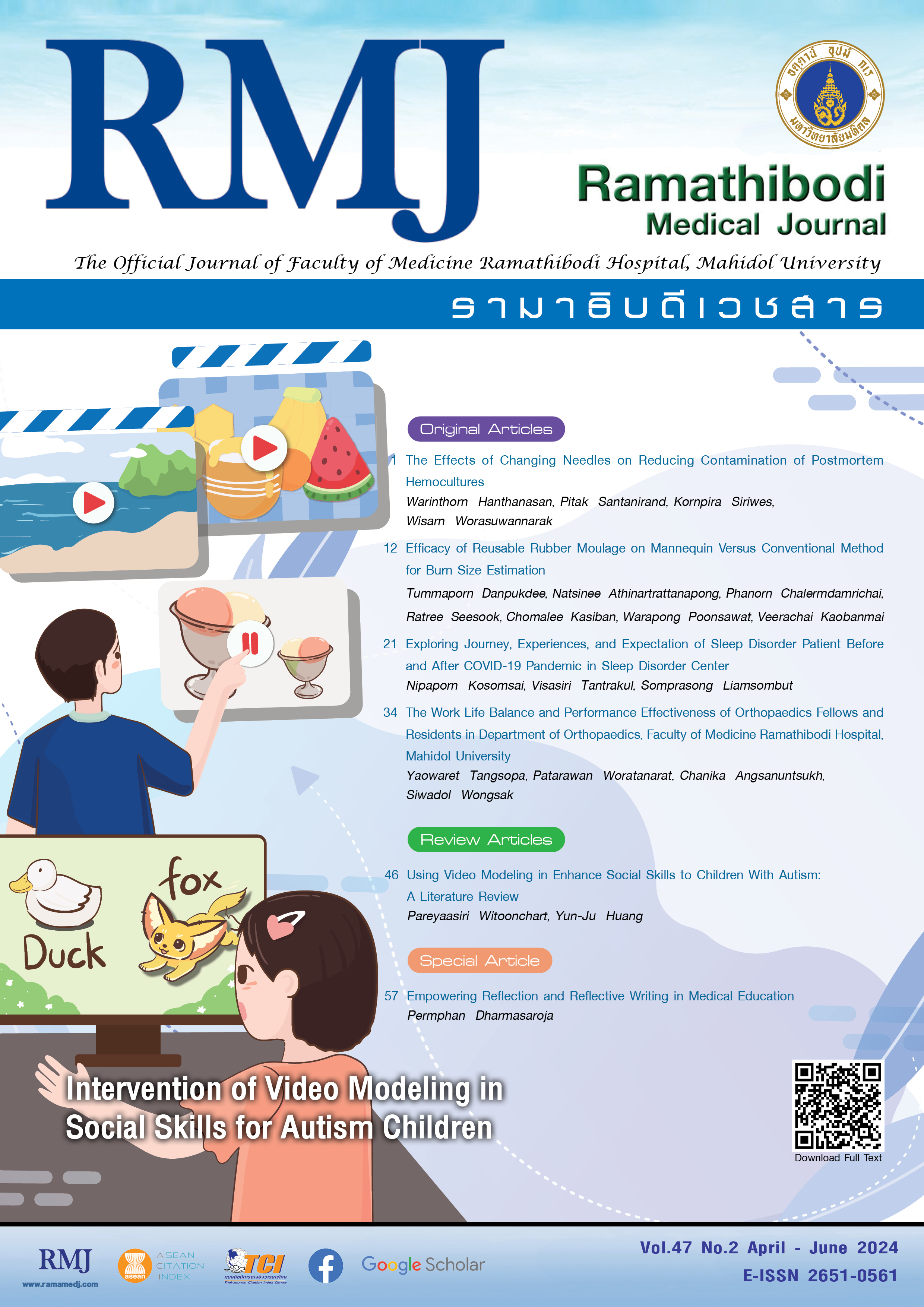The Effects of Changing Needles on Reducing Contamination of Postmortem Hemocultures
DOI:
https://doi.org/10.33165/rmj.2024.47.2.268322Keywords:
Postmortem hemoculture, Needle changing, Autopsy, Microbiology, Forensic medicineAbstract
Background: Sepsis is a common cause of death and can be diagnosed through postmortem hemoculture. However, this method carries the risk of contamination. Some experts have argued that using a new needle before inoculation can help reduce the contamination rates.
Objective: To evaluate the contamination rate from postmortem hemoculture in needle-changing and no-needle-changing groups.
Methods: The present study analyzed postmortem hemoculture results from autopsy cases at Ramathibodi Hospital. Forty deceased individuals who had died within 24 hours and were not suspected of having an infection were included in the study. The blood samples were divided into 2 groups: one in which the needle was changed before inoculation and the other in which it was not. Differences in hemoculture results between the 2 methods were examined.
Results: No statistically significant difference was detected in the positive culture rate between the needle-changing (57.5%) and non-needle-changing groups (57.5%) (P = 1.00). The Kappa coefficient was 0.795. Viridans group streptococci, Escherichia coli, Klebsiella pneumoniae complex, Enterobacter cloacae complex, and Acinetobacter baumannii complex were the most commonly cultured bacteria.
Conclusions: Changing the needles did not reduce the contamination rate from postmortem hemocultures. Microorganisms commonly found in postmortem hemocultures are oral, gastrointestinal, and hospital-associated microorganisms.
References
Riedel S. The value of postmortem microbiology cultures. J Clin Microbiol. 2014;52(4):1028-1033. doi:10.1128/JCM.03102-13
Sunagawa K, Sugitani M. Post-mortem detection of bacteremia using pairs of blood culture samples. Leg Med (Tokyo). 2017;24:92-97. doi:10.1016/j.legalmed.2016.12.009
Wood WH, Oldstone M, Schultz RB. A re-evaluation of blood culture as an autopsy procedure. Am J Clin Pathol. 1965;43:241-247. doi:10.1093/ajcp/43.3.241
Morris JA, Harrison LM, Partridge SM. Postmortem bacteriology: a re-evaluation. J Clin Pathol. 2006;59(1):1-9. doi:10.1136/jcp.2005.028183
Spitalnic SJ, Woolard RH, Mermel LA. The significance of changing needles when inoculating blood cultures: a meta-analysis. Clin Infect Dis. 1995;21(5):1103-1106. doi:10.1093/clinids/21.5.1103
Leisure MK, Moore DM, Schwartzman JD, Hayden GF, Donowitz LG. Changing the needle when inoculating blood cultures. A no-benefit and high-risk procedure. JAMA. 1990;264(16):2111-2112. doi:10.1001/jama.1990.03450160081034
Thamlikitkul V, Chokloikaew S, Tangtrakul T, Siripoonkiat P, Wongpreedee N, Danchaivijitr S. Blood culture: comparison of outcomes between switch-needle and no-switch techniques. Am J Infect Control. 1992;20(3):122-125. doi:10.1016/s0196-6553(05)80176-2
Kassis C, Rangaraj G, Jiang Y, Hachem RY, Raad I. Differentiating culture samples representing coagulase-negative staphylococcal bacteremia from those representing contamination by use of time-to-positivity and quantitative blood culture methods. J Clin Microbiol. 2009;47(10):3255-3260. doi:10.1128/JCM.01045-09
Blot F, Schmidt E, Nitenberg G, et al. Earlier positivity of central-venous- versus peripheral-blood cultures is highly predictive of catheter-related sepsis. J Clin Microbiol. 1998;36(1):105-109. doi:10.1128/JCM.36.1.105-109.1998
Tsokos M, Püschel K. Postmortem bacteriology in forensic pathology: diagnostic value and interpretation. Leg Med (Tokyo). 2001;3(1):15-22. doi:10.1016/s1344-6223(01)00002-5
Smart D, Baggoley C, Head J, Noble D, Wetherall B, Gordon DL. Effect of needle changing and intravenous cannula collection on blood culture contamination rates. Ann Emerg Med. 1993;22(7):1164-1168. doi:10.1016/s0196-0644(05)80983-7
Spiegelhauer MR, Yusibova M, Rasmussen IKB, Fuglsang KA, Thomsen K, Andersen LP. A case report of polymicrobial bacteremia with Weissella confusa and comparison of previous treatment for successful recovery with a review of the literature. Access Microbiol. 2020;2(5):acmi000119. doi:10.1099/acmi.0.000119
Ventura Spagnolo E, Stassi C, Mondello C, Zerbo S, Milone L, Argo A. Forensic microbiology applications: a systematic review. Leg Med (Tokyo). 2019;36:73-80. doi:10.1016/j.legalmed.2018.11.002
Mesli V, Neut C, Hedouin V. Postmortem bacterial translocation. In: Carter DO, Tomberlin JK, Benbow ME, Metcalf JL, eds. Forensic Microbiology. John Wiley & Sons; 2017:192-211. doi:10.1002/9781119062585.ch8
Downloads
Published
How to Cite
Issue
Section
License
Copyright (c) 2024 By the Authors. Licensee RMJ, Faculty of Medicine Ramathibodi Hospital, Mahidol University, Bangkok, Thailand

This work is licensed under a Creative Commons Attribution-NonCommercial-NoDerivatives 4.0 International License.

















